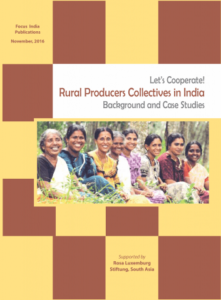17/01/2017
Under: Food Sovereignty and Agroecology, Publications, The Commons
Whether in joint farming, services, or other areas, forming collectives have a number of benefits. Collectives could allow farmers to jointly invest in inputs such as machinery and seeds, to pool and lease land, to build wells and unite in all other efforts to cultivate and market their produce collectively. Cooperatives help farmers buy or sell better due to scale benefits, as well as lower transaction costs for both sellers and buyers. United, producers can more easily arrange technical help in production, processing, or marketing for all of them. (Singh and Singh 2012)
This study booklet aims to provide an overview of producers’ collectives in India, which broadly falls under the cooperative movement. It will also highlight some case studies of successful collective organizations, with a variety of organizational styles and under different laws, mainly to get a taste of the diversity of rural collectives in India.
The paper will start with an introductory section on cooperatives—what cooperative values signify, the difference between top down versus bottom up collective farming models, their brief history, and challenges faced by state controlled cooperatives. After this, we will look at the large cross-section of laws and acts that govern the formation of producers’ collectives in India. We will then move into the so-called new generation cooperatives like Producer Companies and Self Help Groups that have proliferated around the country. Finally, we will look at five case studies. This is followed by a conclusive summary of some key lessons.
Author: Ashlesha Khadse
November 2016
Published by Focus on the Global South
Sponsored by the Rosa Luxembourg Foundation e.V with funds of the Federal Ministry for Economic Cooperation and Development of the Federal Republic of Germany.




![[IN PHOTOS] In Defense of Human Rights and Dignity Movement (iDEFEND) Mobilization on the fourth State of the Nation Address (SONA) of Ferdinand Marcos, Jr.](https://focusweb.org/wp-content/uploads/2025/07/1-150x150.jpg)

